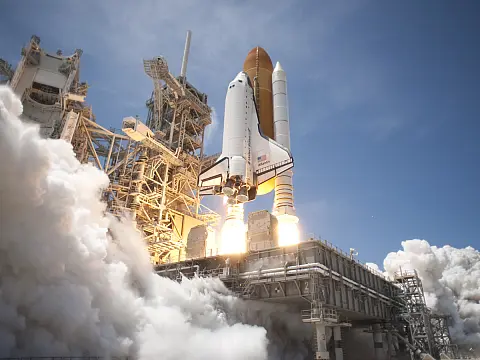The Dangers of Living and Working on the ISSA look at some of the risks and dangers facing astronauts who live and work on the International Space Station (ISS).
Flight is claimed to be the safest mode of transportation, however, does whizzing around the Earth at 7km/s aboard the International Space Station count? Do astronauts residing inside a 747-sized structure with just a few sheets of aluminium for defence stress about the dangers outside?
The Danger of Radiation on the ISS
ISS astronauts are officially classed as radiation workers. A single day on board can expose them to as much as one millisievert which is more or less 4 months' worth of background radiation on Earth.

Space radiation comes from two sources - energetic particles from the Sun peaking from time to time of high solar activity and galactic rays - atomic nuclei shot across the Universe by ancient cosmic explosions. Most radiation of both types is deflected by Earth's magnetic field, which is lucky for the ISS crew as synthetic shielding choices are limited. Parts of the modules are coated with polyethene plastic which is more effective than sheet metal.
The dangers build up farther away from Earth. Radiation encountered by the Apollo astronauts was once strong enough to have incapacitated or killed moonwalkers. Galactic cosmic rays are more hazardous still because those high-energy particles cannot practically be deflected today - astronauts headed to Mars will have to be expecting every cell nucleus in their bodies to be struck throughout the trip.
Drifting Away from the ISS During Spacewalks
During a spacewalk, astronauts experience a particularly peculiar sensation of holding onto a handrail, with nothing touching the bottom of their feet and Earth 400km away. The idea of simply drifting away will have to enter their minds from time to time.

In truth, however, the possibility of drifting clear of the ISS is unrealistic - spacewalkers stay tethered all the time and are provided with an emergency jetpack as a last resort.
Astronauts do lose apparatus. In 2008 a toolbox drifted away, fortunately, it posed no threat. In 2006 a space suit was once turned into a radio beacon and jettisoned from the ISS as an experiment. It drifted forward of the space station for seven months and then it burnt up in the atmosphere.
Space suits aren't always dependable, and more than a few spacewalks were cancelled or cut short because of faults in the suits. EAS astronaut Luca Parmitano had his spacewalk aborted with water from the cooling system leaked into his helmet, covering his eyes and nose. Other spacewalks have been terminated early due to broken gloves, a specific weak point of the space suit design.
Fire onboard the ISS
Fire behaves differently in microgravity; it remains put rather than spreading. A plasma bubble which burns hotter and hotter generating blinding smoke that can rapidly blanket a cabin. When a fire broke out on Mir in 1997 it burnt for 14 minutes, and the six-man crew's fire extinguishers failed to put it out. Instead, Mir's blazing oxygen generator went on burning and spewing blobs of molten metal until in the end burning out when all its fuel was exhausted.
Flames are more difficult to identify in microgravity, burning bluer and dimmer. The ISS has a fire detection and suppression system to monitor for smoke however as soot particles are larger in microgravity it may be falsely triggered by commonplace dust.
Dangers of Shrapnel in Space
The ISS is frequently assaulted by tiny micrometeoroids and small items of orbital debris which are both natural and artificial. Dust from comet trails and meteoroids mingles with paint flakes, frozen water droplets or particles from solid rocket exhaust. Speed not size presents the actual threat. A 1mm metal fragment can strike with the force of a bullet. Natural micrometeoroids possess higher velocities still however are relatively rarer and much less dense. Critical ISS modules are shielded to withstand objects up to 1cm in size at a minimum. The space station is built of more than one aluminium bumper, plus Nextel and Kevlar layers which absorb the impact energy of any such objects before they reach the inner shell.

Spacewalkers are also susceptible as some parts of the spacesuits don't have any shielding. The helmet visor for example does not have any protection. NASA has calculated that the odds of a critical penetration forming a hole larger than 4mm in the 14-layer spacesuit during a 6-hour spacewalk is one in 31,000.
Large Pieces of Debris Striking the ISS
More than 20,000 pieces of orbital debris greater than 10cm can be tracked by way of ground-based radar. Collision avoidance manoeuvres are performed if an object comes within a couple of kilometres of the station and has a collision probability higher than one in 10000. The ISS used to average one collision avoidance manoeuvre per year, but the frequency is rising. Four such manoeuvres were performed between April 3011 and April 2012. In 2011 the crew had been ordered aboard the two Soyuz lifeboats when some debris came 250m.
Debris comes most commonly from defunct satellites, driven to blow up by sunlight heating their batteries or surplus fuel. A collision is a rising source of worry.
NASA scientists have calculated that once past a critical mass of debris, collisions will give rise to extra debris in a chain reaction. This is known as the "Kessler syndrome" and is becoming more and more likely as debris levels in low earth orbit have increased by 50% since 2008. This was helped by way of the 2009 collision of Russian Kosmos-2251 with the US Iridium 33 satellite plus in 2007 China fired a missile test targeting its weather satellite.









